SafeHome.org may receive compensation from some providers listed on this page. Learn More
We may receive compensation from some providers listed on this page. Learn More
SafeHome.org may receive compensation from some providers listed on this page. Learn More
We may receive compensation from some providers listed on this page. Learn More
A DIY home security system with touchscreen controls and reliable monitoring
While they’re not the most well known or popular home security system in the industry, I’ve consistently heard good things about Alder Security, and I was pretty excited to take their equipment for a spin. After a few days of in-home testing and quite a bit of research, I’m happy to share everything I found with you — the good, the bad, and the unexpected.
Right off the bat, I did notice that their prices are a little higher than comparable DIY options. Ring Alarm pricing is a bit lower, as are SimpliSafe costs. I was happy to see a nice seven-inch touch-screen control panel included in the box, though, so I could see where some of that money went.
Before I get too ahead of myself, though, let’s take a quick look at what I was expecting, what I found, and some overall pros and cons.
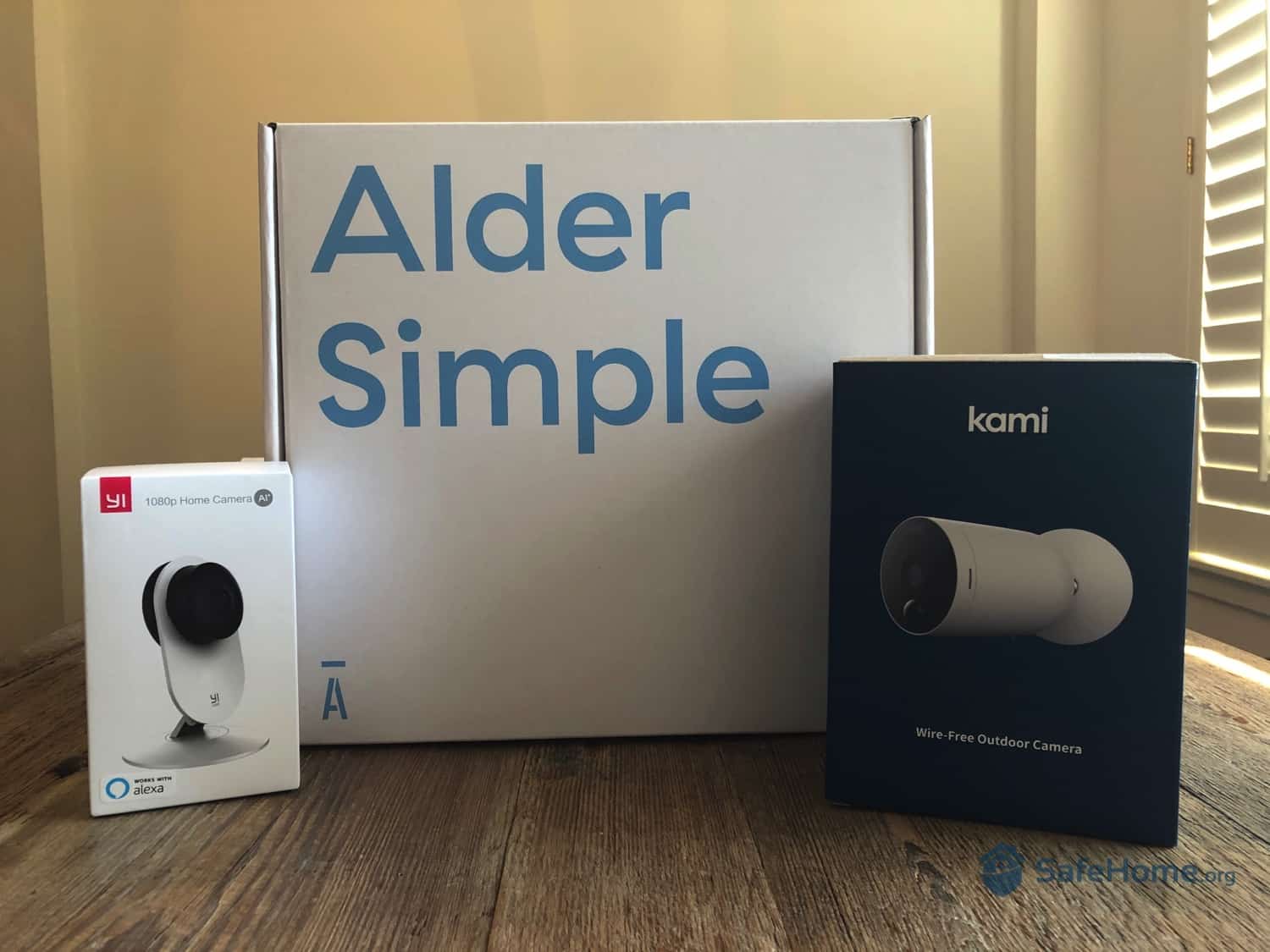
Alder Packaging and Boxes
I’m a big fan of any tech gizmo or gadget, but I totally understand that when you get too deep into the bells and whistles, things can get complicated pretty quickly. That’s why I like to keep things as streamlined as possible, especially when it comes to home security. This is why the Vivint Home Security System is a favorite of mine, but phew — that price tag. I’m hoping that Alder can provide the same simplicity while being a little more friendly to my budget.
After testing the system for nearly 60 hours, I found that Alder is a solid perimeter alarm system with reliable 24/7 monitoring. It works fine for basic intruder protection; but if you just get the basic system, you’ll be missing out on things like video and smart home features. And if you’re looking for a streamlined user experience, there may be better systems out there. In particular, I didn’t like the app user experience, as the app itself is barebones but somehow complicated to operate.
With all that being said, let’s dive in and see how Alder did.
Check out more recommendations from the SafeHome team:
The Alder kit came with a handful of sensors and the handsome 7-inch touch-screen panel you see below. Now take a closer look … see something missing? Alder doesn’t include a base station, which is a critical component with most systems. Instead, the touch-screen panel works double duty as your control center and smart hub, which is very cool.
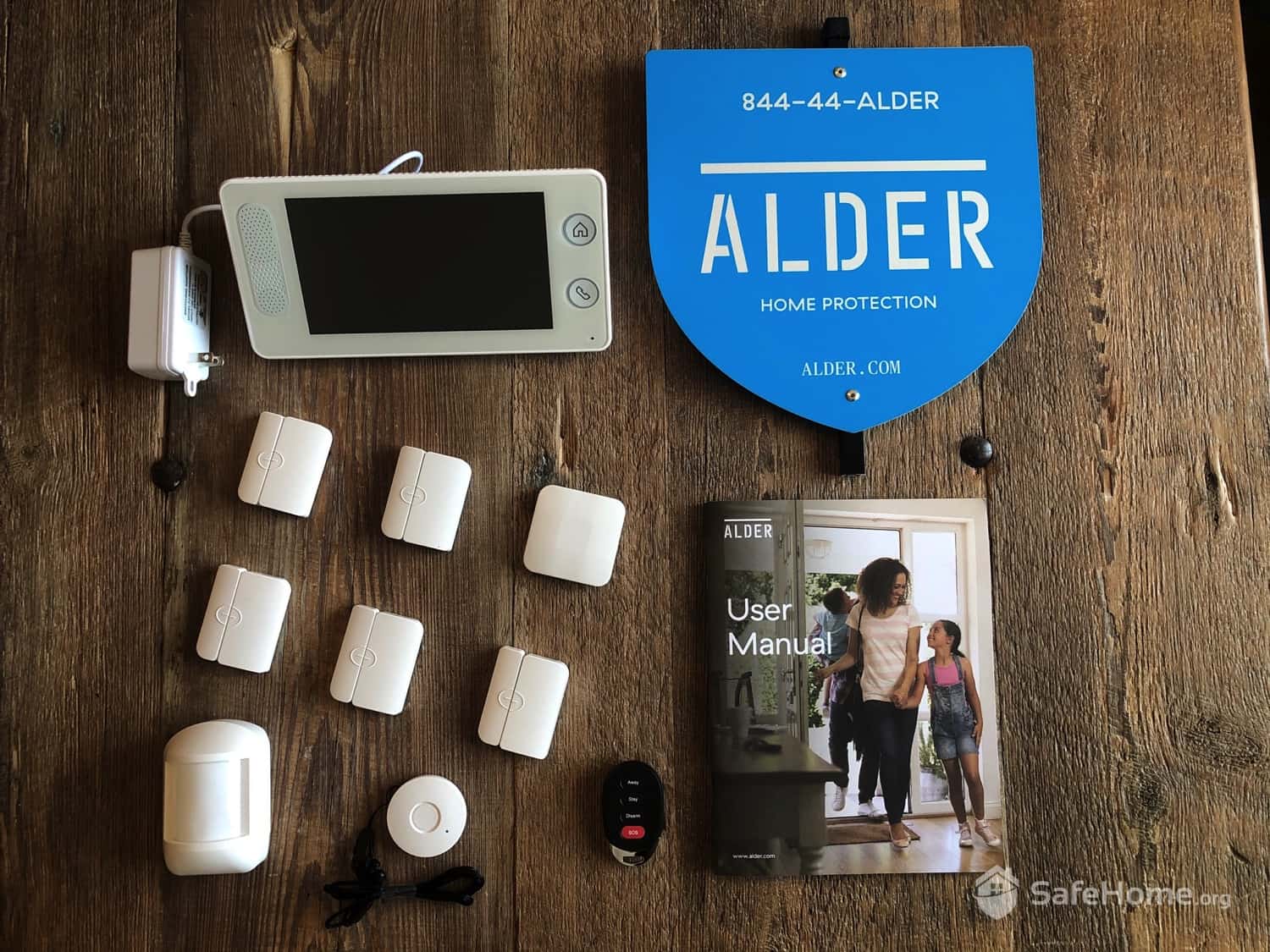
Alder Security Equipment
Keep in mind, Alder does things a la carte, meaning you’re going to have to work with a representative to build your security system from scratch — there are no pre-made kits here or purchasing pieces of equipment directly from the company. My kit cost $450 and included the following equipment:
You’ll have to call Alder to order, as they don’t list products or prices on their website. I don’t really care for this approach; having to order by phone is like a time-warp to the ’90s, especially for a DIY system. Then again, it was nice speaking with a rep and getting a rundown on their equipment and options.
Pro Tip: Alder requires a phone consultation before you buy, which is a great opportunity to flex your negotiation skills. Don’t want to sign a contract or pay the $49 activation fee? It never hurts to ask!
As they say, you only get one chance to make a first impression, and Alder did not disappoint. Their sensors were all sleek and sported slim profiles — they were hardly noticeable once they were installed. That’s great news, especially when you compare it to some of the more boxy, obtrusive equipment at this price point.
Take a look at the entry sensors from our Frontpoint review, for instance. Those things were so big that they could barely fit on my palm. Alder’s entry sensors, on the hand, were slimmer and sleeker, with a depth of only about half an inch and a width of about one inch.
The control panel was also impressive. It was intuitively designed and had that satisfying heft you’re looking for when you pick up a piece of electronic equipment. You know what I’m talking about. It didn’t feel flimsy, it felt … substantial. Not that I would, but I felt like I could hammer nails with the thing. Maybe that’s not the best test of how well a piece of equipment is made, but it gave me the confidence that I wouldn’t be replacing it in six months.
On that note, there’s a reason we test the hardiness of the security products, particularly hubs and control panels. There are burglars out there that would smash and crash their way into your home, and they’re not beneath destroying security system hubs to deactivate monitoring. With the Alder control panel, it felt like it could withstand a few impacts and make a last stand to alert the monitoring center so they could drive the burglars away.
So overall, yes, I was very satisfied with how everything looked and felt. So I was excited to get everything installed.
Alder claims that setup only takes 10 minutes, but I beg to differ. It’s definitely do-it-yourself easy, but it still took me about 35 minutes to install. Thankfully, once you plug in the touch-screen panel, the install wizard walks you step by step through the process. You’ll want to get cozy with the control panel, as you’ll be using it A LOT with Alder.
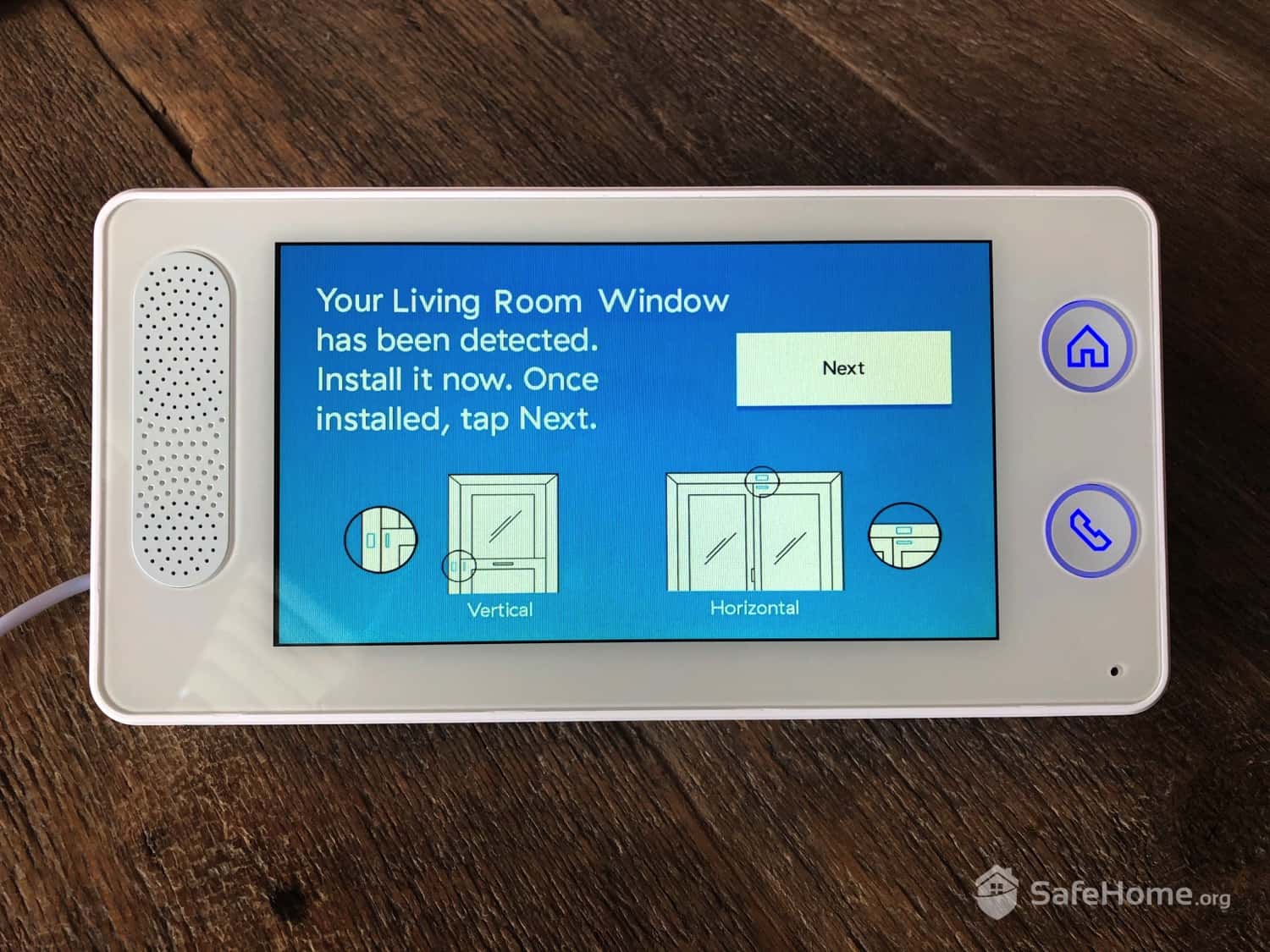
Alder Hub connecting to Sensors
The first thing the install wizard will have you do is to pair each sensor to the control panel. You’ll do this manually, and although it comes with detailed on-screen instructions, I wasn’t a big fan that I had to do this step myself. I’ve tested many DIY systems that shipped pre-programmed equipment so that all I had to do was place the sensors. Check out my SimpliSafe review, for comparison. That system took just 20 minutes to install, even the security cameras.
Other than that, I’d say that Alder’s installation process is a breeze. The sensors had double-sided tape backing for easy placement. Peel cover and stick; it’s that easy.
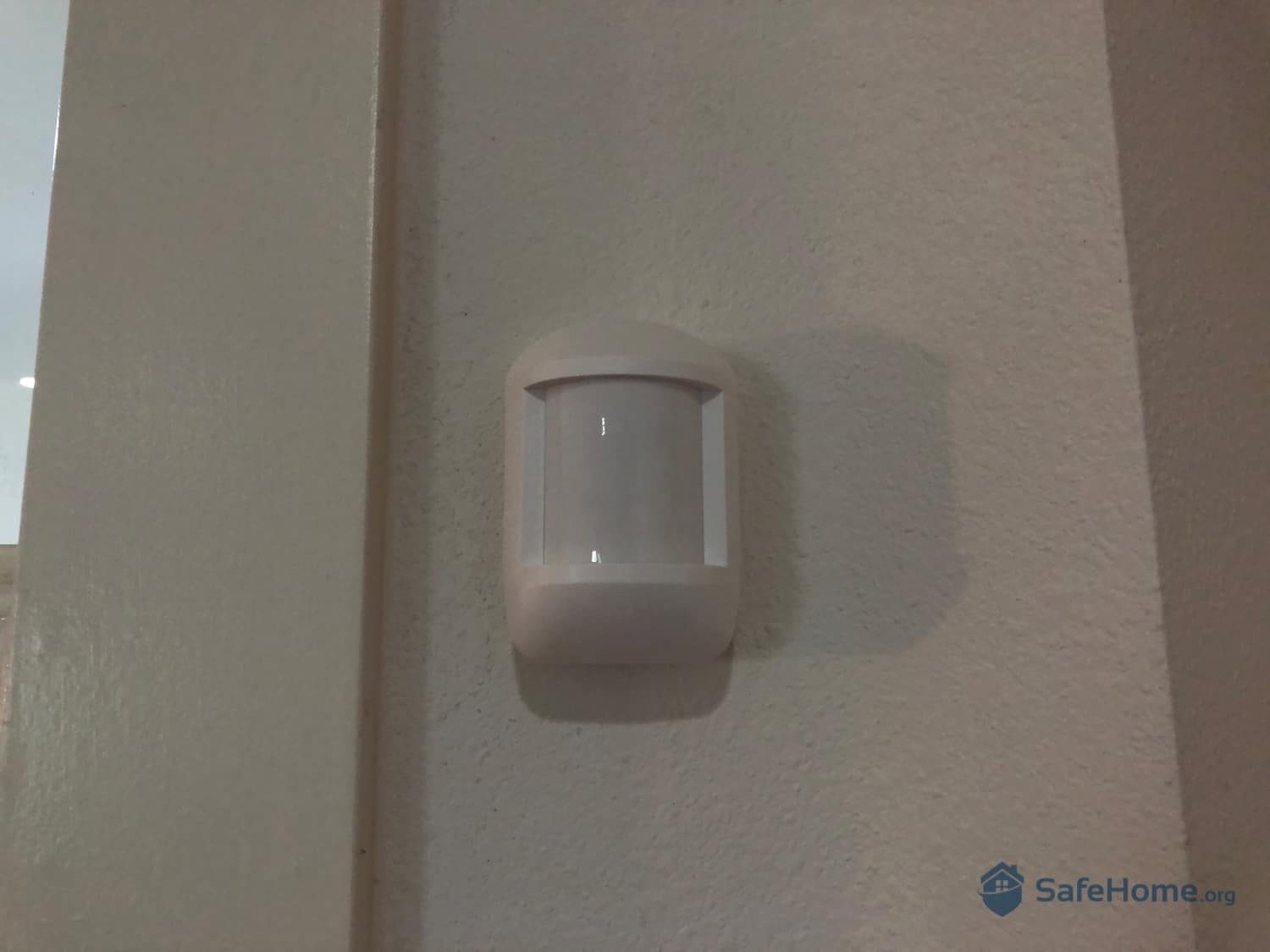
Alder Motion Sensor
The sensors are similar in size to Ring Alarm’s streamlined 2nd Gen sensors, though Ring sensors are a bit better looking. Check out the snapshot below, with Alder sensors on top and Ring sensors on the bottom.
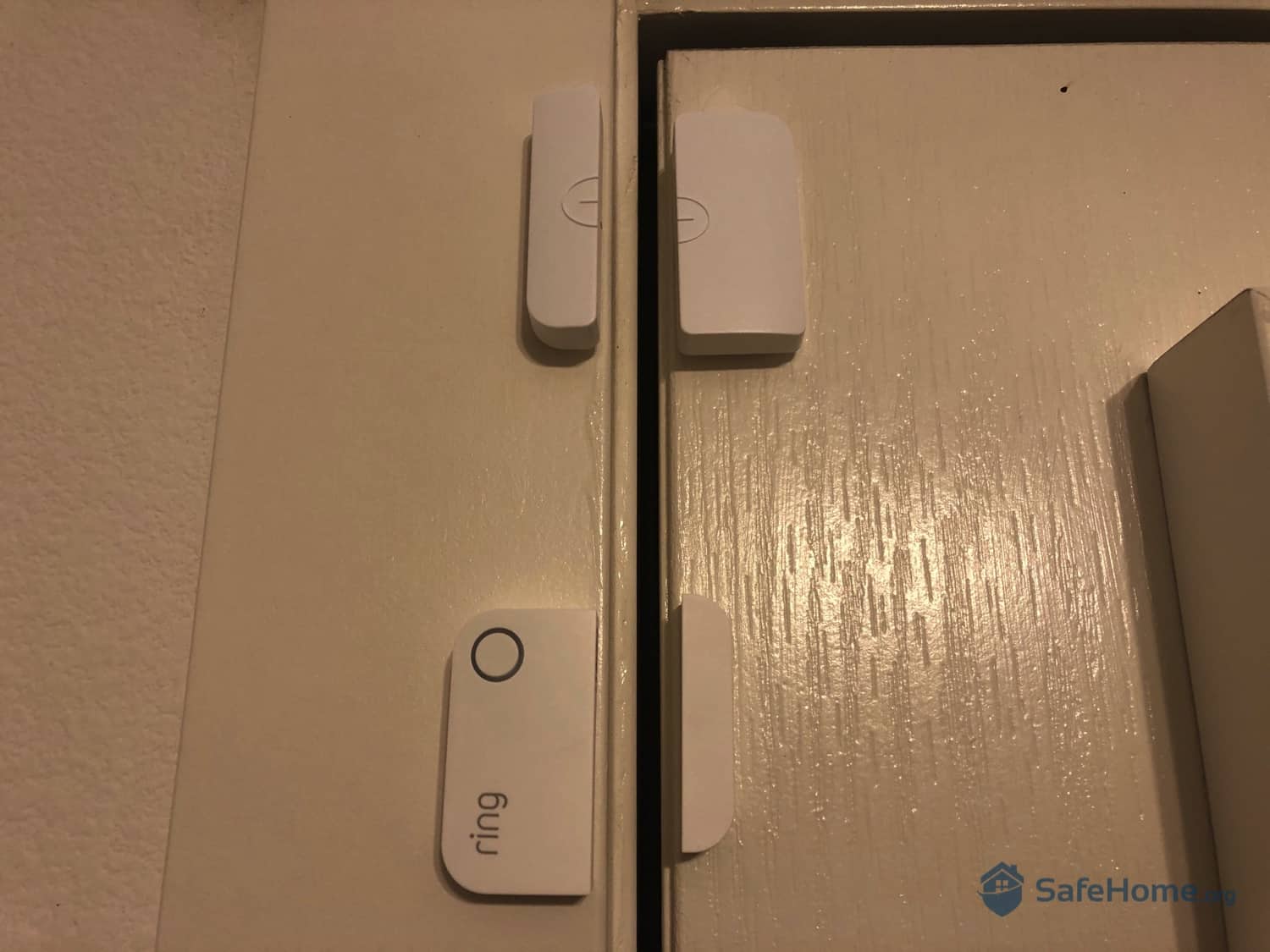
Alder and Ring Entry Sensors
Not bad, right? I actually appreciate Alder’s unbranded approach. It helps the sensors blend in better with the wall.
After installing the sensors, I had some difficulty setting up the 24/7 monitoring. When I called Alder customer service for help, I was put on hold for a full 30 minutes (not good!). Thankfully, a fellow named Geno from tech support came on the line and got me back on track.
I came across some eye-opening things during my hands-on experiment with Alder — some good stuff, and some not-so-good stuff. Let’s start with the controls. I accessed and controlled my Alder system using primarily the touch-screen panel, though there are a couple of other options.
Alder’s controls include:
FYI: Most DIY home security systems are controlled primarily with the app. But with Alder, I mainly used the control panel and key fob, as Alder’s mobile app left a lot to be desired. Needless to say, Alder isn’t the best fit if you like doing everything from your smartphone.
The 7-inch touch-screen control panel is the crowning jewel of the Alder system. But Alder’s panel doesn’t really measure up to the Command touch-screen panel you get with ADT Control; nor is it as impressive as Vivint’s Smart Hub. (Read about that powerhouse in our guide to Vivint home automation.) The ADT and Vivint devices are like full-on tablets, whereas the Alder panel is more limited in functionality. It’s kind of like the difference between a modern iPad and an early-2000s PalmPilot. Remember those?
Another thing to note: Alder’s control panels require constant power, so you have to mount them near a standard outlet. That doesn’t mean you’ll be left unprotected during power interruptions, though, as the control panels have 24-hour battery backup. Even if power to your house goes out, the control panel will be able to protect your home from intruders and other criminals.
Alder’s smart hub sure beats the standard push-button keypads you get with other DIY brands. (Even Ring’s 2nd Gen system still comes with a push-button keypad!) With Alder, you’ll enjoy countdown arming and disarming timers, as well as entry announcements directly from the panel. So when someone comes in the front door, Alder will announce “Front door open.” With cheaper systems, all you get is a simple chime.
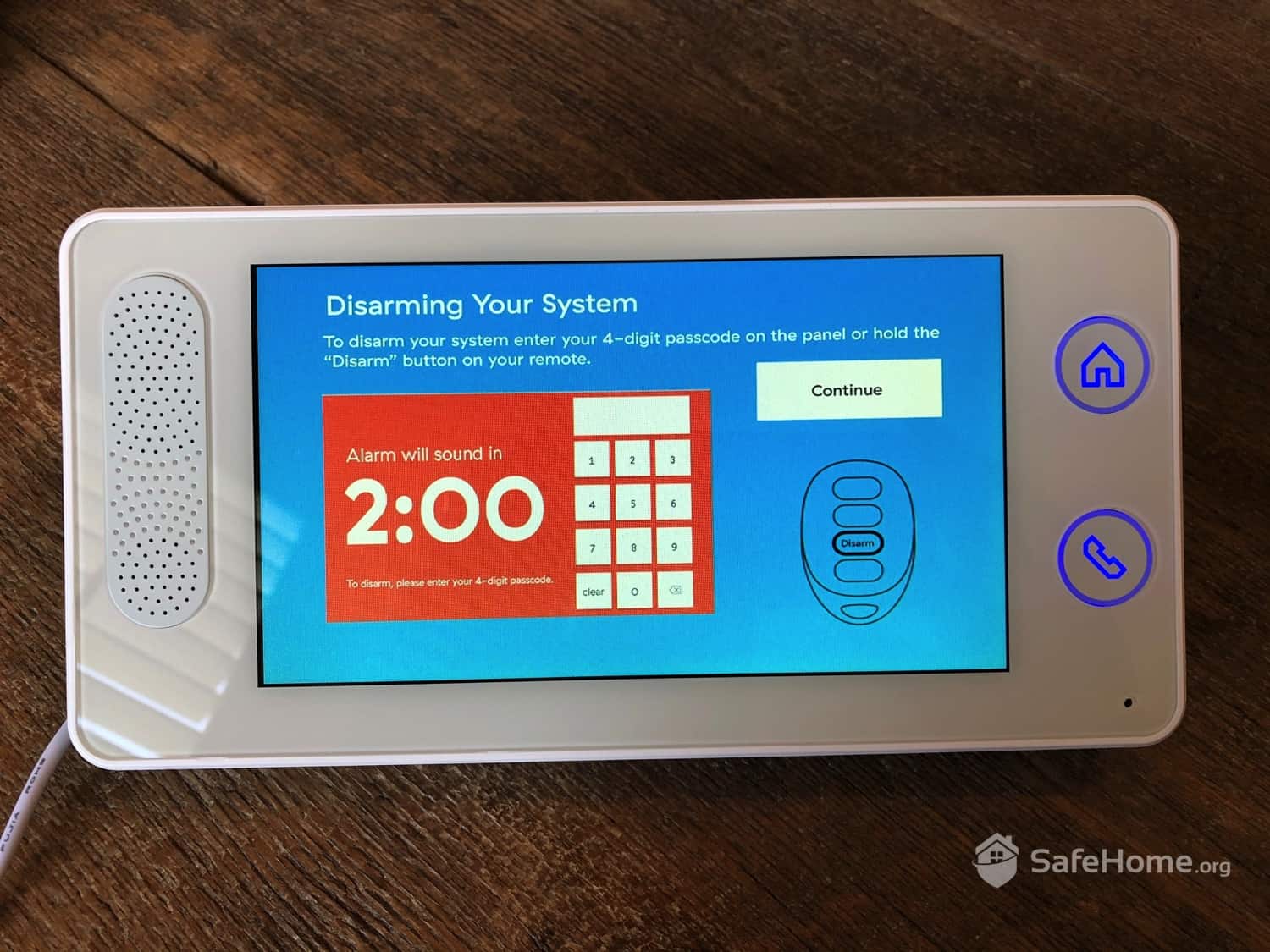
Touchscreen Panel
So let’s say you’re eating dinner at night and hear “Bedroom window open.” You can get your wits about you, flee the house, and call the police with the exact location of your tripped sensor. Very helpful! You can also select whether you want the voice to be female or male, which is a nice little feature.
Of course, the audible announcements can also play a role in stopping burglars in their tracks. Just imagine how you would react if you were a thief and you heard a person’s voice announcing your entry. It may not be as effective as a siren (though Alder has that too!), but the announcements are a nice addition to Alder’s crime-deterrent features.
Pro Tip: There’s a nifty “envelope” icon in the top right corner of the home screen. This displays your 200 most recent activities (doors and windows being open and closed, alarm triggers, arms and disarms, panel tampers, etc.). You can customize your activity log in “settings.”
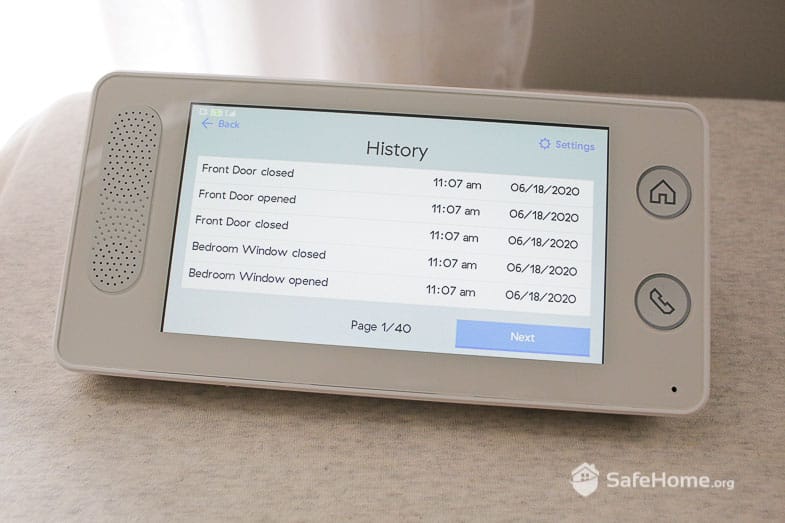
Alder Touchscreen Control Panel
As with any touch-screen panel, you’ll have to deal with grubby fingerprints and smudge marks from time to time. But Alder has a solution for this. The panel has a “screen cleaning” mode that turns off all controls for 30 seconds, allowing you to wipe it down without triggering any functions. (It’s the little things … )
One thing I didn’t like about Alder is the software, particularly the mobile app. Alder used to be on the SecureNet network,1 but they’ve now developed their own mobile app so you can control your system using your smartphone.
The Alder app only gets two stars in the app store, but I’d hesitate to give it even that. One Google Play user called it “bugs galore,” and I agree. The notifications were late, the security cameras would stop recording or detecting movement all of a sudden, and worst of all, there was one time it didn’t let me log-in to my account at all.
It’s important to recognize that Alder is somewhat new to the app game, so hopefully they’ll fix the bugs in the months to come. That said, their app score has actually gone down a star over the last year.
Unlike some other home security apps we’ve tried, Alder’s app doesn’t offer super advanced features. You’ll be able to view your video stream, arm and disarm your system, customize your sensors, and check your activity log. That’s about it.
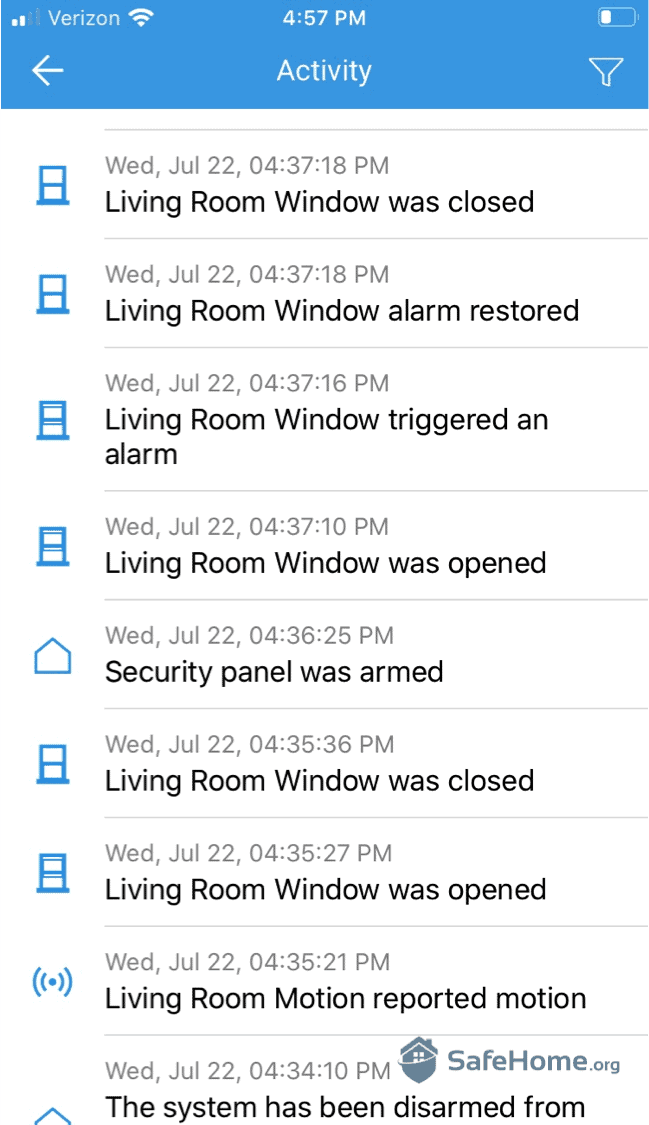
Alder App Devices
The design isn’t so hot either. Alder went with a red and yellow interface, which really doesn’t work with their blue and white branding. It gives off some serious Ronald McDonald vibes. See the image below.
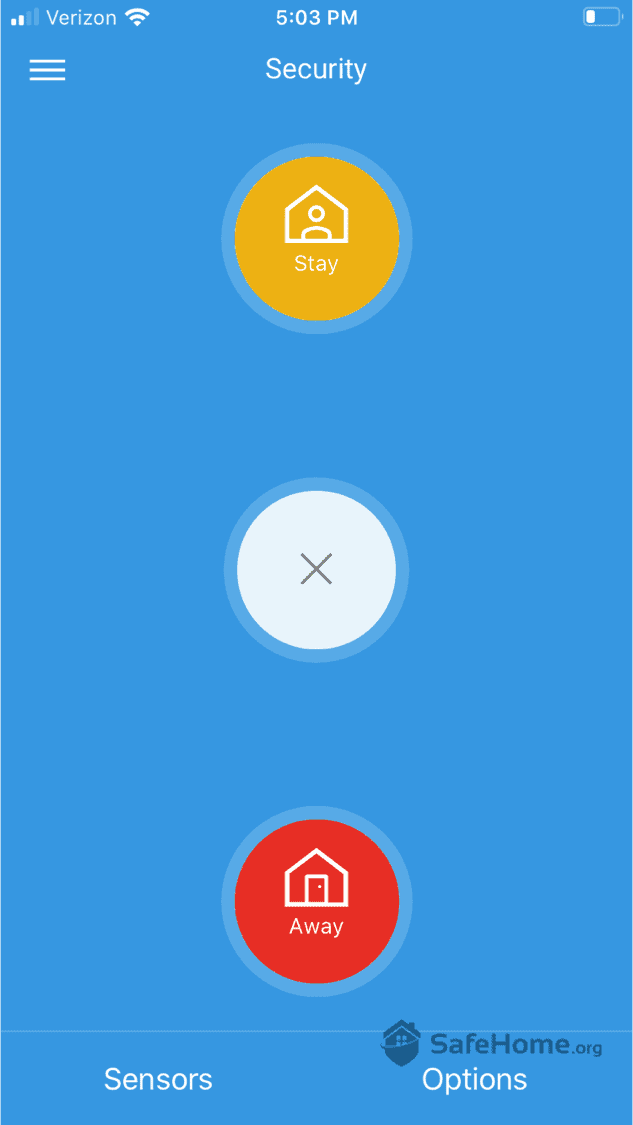
Arming the Alder App
One thing you may find annoying is that you have to input your four-digit PIN every time you want to open the app. I actually thought this was a tech issue, and I called in, only to be told that that’s how it was designed. So whenever you have a false alarm, it’ll take you an extra five to 10 seconds to input your PIN and wait for the app to load. (At times, I wasn’t able to access the app at all; I’d just get a “timed out” message.)
FYI: You have several ways to control your Alder system: touch-screen panel, mobile app, and key fob. So if one doesn’t work, at least there’s a backup!
I wish I had better news to report on Alder’s app. After all, smartphone controls are great. It’s how I prefer to manage my home security and smart home equipment. Any new software is bound to have its bugs, but it does seem to be taking Alder some time to iron things out.
When not using the touch-screen panel, I mostly controlled my Alder system with the key fob. It’s fast and easy, just like a car alarm remote. But there are a couple of things to note here. You have to be within 100 feet of your house, and you have to press the button for a full second (one Mississippi) to arm or disarm your system. Once, when returning from the park with my pup, I thought I’d pressed the button long enough to disarm the system, but the blaring siren upon entry told me otherwise. Oops.
You might be wondering if Alder has what it takes to scare away intruders. Well, you’ll find that the siren is louder than loud. It’s only rated around 85 decibels. (You normally want to see 110 to 120 decibels.) But the pitch of the Alder alarm is absolutely ear-piercing. It’s definitely loud enough to make the bad guys get out of Dodge.
Did You Know? Alder’s siren is loud, but the other system functions don’t have to be. The “Silent Exit” feature will let you arm your system announcement-free. This keeps the control panel quiet as you leave the house. It’s a great feature, especially if you have little ones at home, or if you or your spouse leave for work early in the morning.
One thing you’ll like about Alder is their responsive monitoring. If someone tries to break into your home, your sensors will send a signal to the monitoring center, and Alder will reach out. And if there’s a need to call first responders, they’ll do so on your behalf, and quickly, I might add.
How fast? Well, not as lighting-fast as they say. Alder claims that in 2017, their response times averaged at 3.4 seconds, which is in fact, 10 times faster than the industry average. But in my experience, the response times were closer to 30 seconds. Again, that’s the industry average, so not bad, but I wouldn’t count on the 3.4-second average response times posted on their website.
Here’s how Alder’s response time ranked against the security systems I’ve tested with the fastest response times:
| Home security system | Response time |
|---|---|
| SimpliSafe | ~20 seconds |
| Alder | ~30 seconds |
| Vivint | ~35 seconds |
| ADT | 30-45 seconds |
| Frontpoint | ~50 seconds (including 30-second entry delay) |
When my alarm went off, Alder contacted me using either two-way talk, which is built into the control panel, or by calling my cell phone. The two-way talk feature is another nice addition to Alder’s arsenal of crime-preventing features, and it’s one we don’t see often. Since control panels are usually placed in an accessible location (e.g. near the front door), Alder’s monitoring center agents can scare away thieves and intruders themselves.
That said, it may take time for an agent to reach out. During one of my tests, it took their agents a full 45 seconds to reach out. A responder came through using the two-way voice and asked, “Is there an active emergency?” I told her no, and then she asked for my “safe word” and my name. All fairly standard … at that point, at least.
Then the strangest thing happened. When she said goodbye, I could still hear her fiddling at her desk for another 10 to 15 seconds before she finally hung up! So she could certainly hear anything that was spoken in my home during that time, which makes my spidey senses go off for privacy reasons. Then, when she finally hung up, the siren started blaring again. Needless to say, it wasn’t the best experience.
Despite that isolated issue, I was pretty happy with Alder’s 24/7 professional monitoring service. Most of the time, the agents contacted me via phone, and the interactions were flawless. And since Alder is 100 percent cellular-based — using 4G LTE cellular monitoring2 — I felt that our signal was reliable, and our system was always connected.
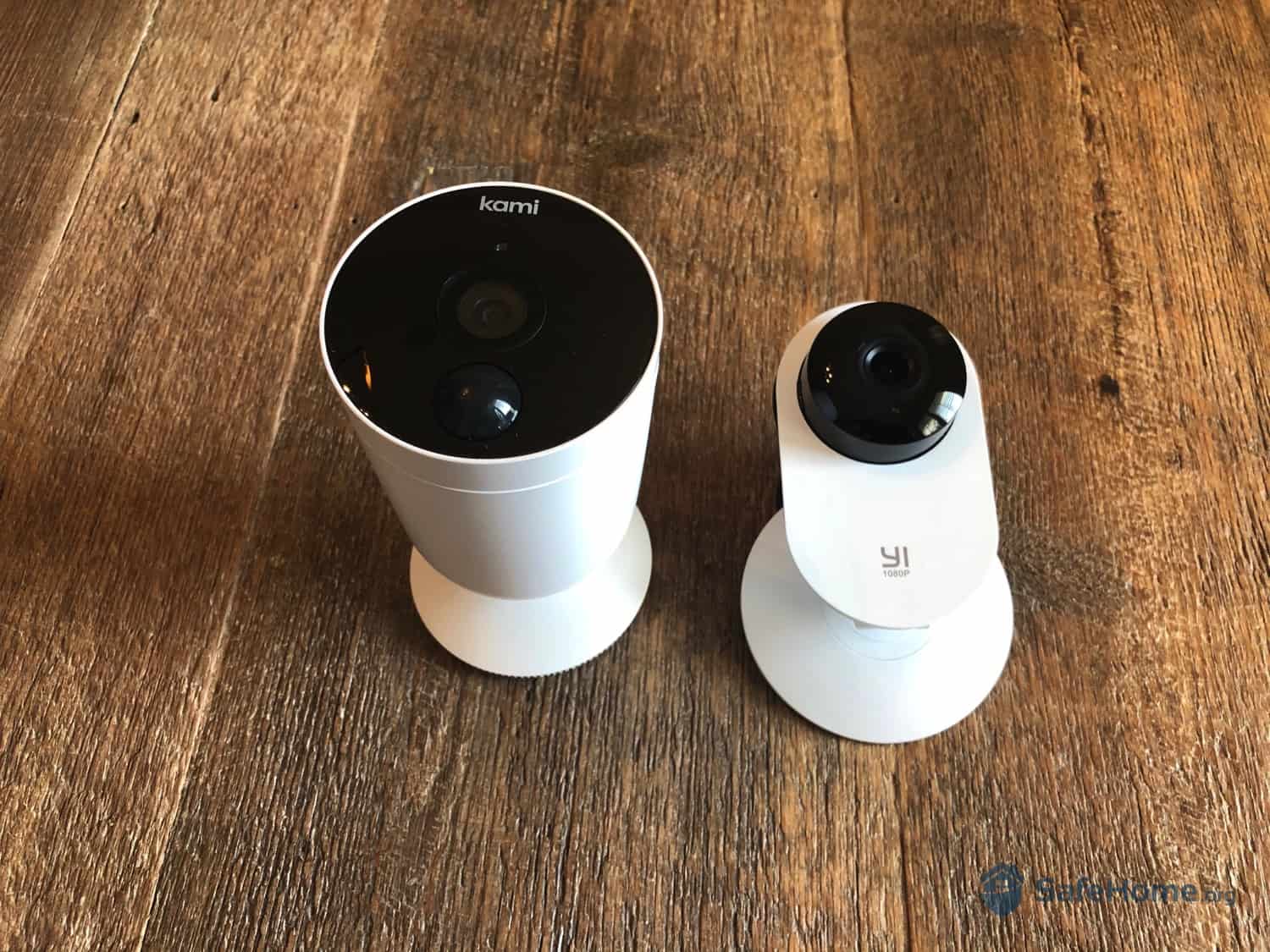
Alder Security Cameras
Alder does not make its own cameras … yet. They currently sell the outdoor Kami camera and the indoor YI cam, both made by YI Technologies. Both devices are solid, with features like 1080p HD resolution, night vision, smartphone controls, and two-way talk. The Kami even has AI-powered facial recognition, a feature usually seen in higher-end cameras like the Vivint Outdoor Pro, or like what you’ll see in our review of the Google Nest Cam.
The cameras offered by Alder have some impressive features, but when I tested them, they didn’t integrate into Alder’s app. That means I couldn’t view live footage from my cameras in the same app where I controlled my security system. Instead, I had to download the YI Home and Kami Home apps, which was disappointing.
Alder has since integrated the YI cameras into the Alder app, which is a step in the right direction. However, given that Alder’s app score has actually gone down a star since I tried them out in my home, it’s unclear how well these camera integrations are working.
When it comes to camera integrations, it’s worth noting that you can’t view a live video feed on the Alder touch-screen control panel like you can with the best home security systems like ADT and Vivint. I like having access to all of my home security devices in one place — as I think most people would. So I have to dock Alder some points here. Otherwise, the security cameras performed well during my hands-on testing.
Pro Tip: I recommend going with Ring cameras for indoor and outdoor video surveillance. A couple of Ring’s models even have built-in lights for an added layer of protection. Check out our Ring Spotlight Cam review and our Ring Floodlight Cam analysis for more details.
Having outdoor cameras is a great way to add protection to your home. As a patrol officer responding to burglary calls or most property calls, one of my first questions was if there was any video footage. Video footage can capture images of involved suspects and vehicles. Having pictures and images of suspects and vehicles greatly increases the chances of a case being solved and criminals being arrested.
Alder offers a whole lineup of environmental sensors. Their “Life Safety” products include smoke and carbon monoxide detectors, along with freeze and flood sensors. They also have a medical alert pendant, which is not something you typically see from home security companies.
We do loads of research and testing of medical alert systems, and they can be lifesavers, especially for seniors who are at increased risk of injury from falling.3 (Check out our roundup of the best medical alert systems.)
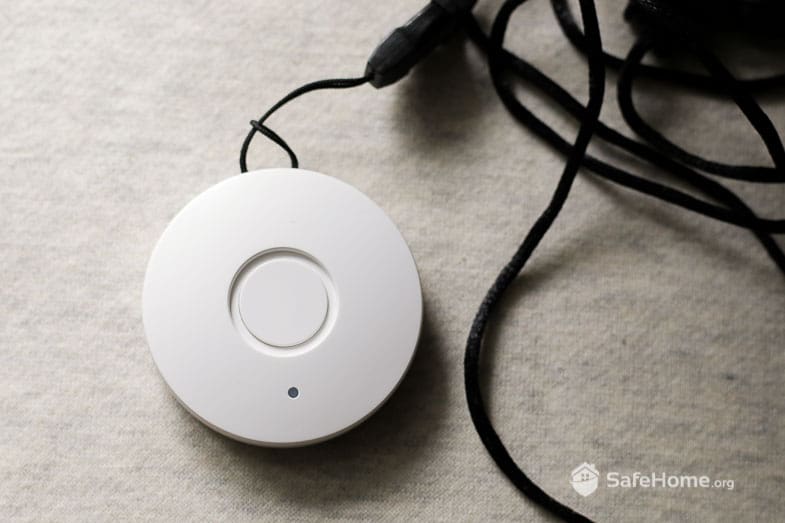
Alder Pendant
Alder’s medical alert pendant is an unsightly little thing, but it certainly gets the job done. Just hold the help button for two seconds, and it’ll signal the monitoring center. I experienced 20-second response times on average. Kudos to Alder for even offering this service, as most home security brands don’t have any medical alert options.
Alder doesn’t list their equipment or monitoring prices on their website. I had to call in to get a rundown of their costs, so I can’t quote exact figures here.
With that said, Alder does require a one-time activation fee of $49, plus your first month’s bill for monitoring and equipment financing. This worked out to $44.99 per month for the monitoring package I purchased, but prices may vary. Alder does offer a plan for as low as $40 per month, which doesn’t quite land it among the most affordable home security systems, but it’s still in line with industry standards. Check out our latest breakdown of Alder home security pricing, but here’s a quick brief:
| Monthly monitoring rates | $39.99 to $54.99 (based on the quote we received) |
|---|---|
| Equipment cost | $450 (for a mid-sized system) |
| Equipment payment | Upfront or financing |
One important caveat with Alder: Be ready to sign a contract if you don’t purchase your equipment up front. The contract term may vary. When I recently tested the system, the contract term was 42 months, but just a few days ago I called Alder and was quoted a 60-month term. Though long-term contracts are somewhat common for professionally installed security systems like Vivint and ADT, they’re a bit unusual for DIY systems. But if you plan to have your system for a few years, as most people do, a contract shouldn’t necessarily be a deal-breaker. Also, Alder has a 30-day, risk-free trial, giving you an “out” if you end up not liking them.
For what to expect from an Alder security system, check out the most important specs and features below.
| System communication | Cellular |
|---|---|
| Professional monitoring | Yes (required) |
| System setup | DIY |
| Setup time | Around 30 minutes |
| Average monitoring response time | 30-45 seconds |
| Control panel | Touchscreen |
| Sensor options | Entry, motion, glass break, etc. |
| Indoor and outdoor security cameras | Yes (integrated third-party cameras) |
| Home coverage | 1,500 – 3,000 sq. ft. |
| App compatibility | iOS and Android |
| Equipment warranty | Lifetime |
| Monthly cost for monitoring | $40 to $55 (estimate) |
| Equipment cost | Around $450 |
| Financing options | Available (up to 60 months) |
| System release date | 2017 |
Now, Alder is a very reliable security system overall. It uses pretty good technology, the response time is fast, and although the app leaves things to be desired, the touchscreen control panel propels Alder beyond most DIY security systems.
That being said, not everything works all the time and there’s a good chance that at some point, you’ll have to talk to a customer support agent for help. That’s where Alder becomes a little lopsided.
“I could hardly understand what [the customer support staff] was saying, and she kept messing up repeating my information back to me,” one user wrote about their customer support experience.
Another user said: “I called for technical support in changing the record time on one of my cameras. They asked me for my username and password for my app in order to assist me. I declined and asked [that] they send me written instructions. They hung up on me.”
These reviews show that Alder isn’t perfect, but my personal experience also tells me that it’s not all bad when it comes to their customer support. I’ve called them up a few times and they were mostly helpful.
Using our SecureScore rating methodology, I give Alder an 8.8 rating out of 10. Our ranking system averages Alder’s scores in five major aspects: customer support, value, equipment quality, features and technology, and ease of use.
Alder offers reliable home security without a lot of frills. It’s not a perfect system. There’s really no such thing. For instance, I don’t like the limited camera options and smart home features. (If you want a smart home system, check out our guide to the best home automation security systems.) And if I’m being honest, the Alder app doesn’t deliver the best user experience.
On the other hand, I felt very secure in my home, knowing that Alder’s reliable 4G LTE cellular monitoring was always there for me, and that goes a long way. Also, everything was simple to set up and get started, and I really enjoyed using the touch-screen control panel. So even if you’re new to home security systems, I think you’ll find Alder to be a good perimeter system for burglar detection.
Even though I’m not completely impressed by everything Alder has to offer, the system still checks most of the boxes for quality home security. So if you’re considering a DIY system, it might be worth hopping on a call with one of Alder’s sales reps. All things considered, it’s not a bad solution for home security.
In our continuing quest to be the best source of unbiased home security system reviews, our expert team is always on the lookout for brands that offer dependable security equipment and monitoring. Our process starts with in-depth research. We spend countless hours comparing and gathering information about security systems and the companies that sell them.
When we find security systems we want to test; we go straight to the source and go through the normal sales process. Next, we set up the security system in our home and test each and every feature extensively, taking note of the strengths and shortcomings we find, and how the system protects us and our family. We also simulate security breaches to see how well each system detects them.
All in all, we spend at least a week testing each system, but we like to keep the security systems around for a month or so to gain first-hand experience on long-term user-experience. After all, security systems are meant to last years.
Yes, Alder does require professional monitoring. They don’t offer a self-monitoring option.
Yes, Alder offers two security cameras — an indoor and an outdoor model, manufactured by YI Technologies.
No, if you buy your equipment up front, then you don’t have to sign a contract with Alder. However, it may be more affordable to pay for your equipment over time, in which case you’ll have to sign a 42-month contract for equipment financing.
Yes, but Alder’s mobile app is somewhat buggy; it’s rated 2.2 stars in the app store and 3.3 stars on Google Play. It’s still a relatively new app, so hopefully the kinks will be worked out in time.
Yes! You’ll really enjoy Alder’s 7-inch touch-screen control panel. It’s very well made and offers lots of helpful features.
SecureNet. (2020). Security Dealers.
https://www.securenettech.com/security-dealers/
Klein, M. (2016, October 7). What is 4G LTE?
https://www.howtogeek.com/273745/what-is-4g-lte/
National Council on Aging. (2021). Get the Facts on Falls Prevention.
https://www.ncoa.org/article/get-the-facts-on-falls-prevention